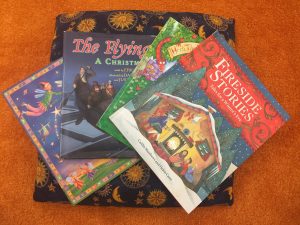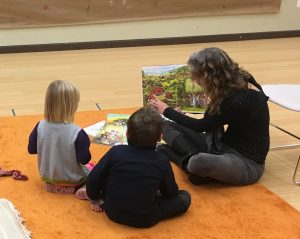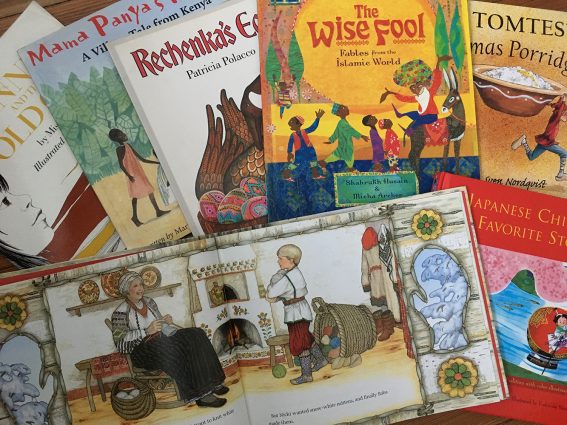Multicultural folktales and legends have been the fare for families with children, ages 3 to 7, in an expanded Washington Revels story time program this spring. World Story Time (WST), said Ross Wixon, the Revels’ marketing director, is “part of Revels’ broader mission to unite people and to encourage cultural understanding and civil discourse by celebrating the many traditions that have bound together communities around the world and throughout time.” The free hourlong sessions took place for six weeks on Tuesday mornings in the Revels’ Studio Space in Silver Spring; they will resume in the fall.

“Primary storyteller Jo Rasi,” Wixon explained, “transitioned from her longtime position as marketing and programs director to focus on and develop participation-based and service-oriented offerings.”
Rasi, whose academic credentials include a bachelor’s degree in English and a master’s in performing arts studies, has served as an arts administrator, consultant and event planner for nonprofits and federal and local government agencies for more than 25 years—among them, the American Folklife Center at the Library of Congress, the Veterans History Project, the National Council for the Traditional Arts, the Grateful Dead and the North American Folk Alliance.
Suzanne Miller and her husband began taking their 5-year-old daughter to WST in September. She loves “that it brings the community together,” nothing that “for young children and their parents, sometimes it can be hard to connect with other kids and give your children exposed to new ideas. It’s nice to meet other parents and kids, as well as to feel connected to the broader Revels community.”

Another attribute of WST Miller identified is that “it allows kids to learn about other cultures and traditions in an empathetic and interactive way. Stories from African, Native American, Asian and European traditions all make their way into the story times, which often have a topical or seasonal theme to unify them.”
As for Rasi, Miller said, “Jo does a great job of providing several levels of engagement appropriate to different ages. There are coloring sheets to keep hands busy as little ears are listen. There are pillows and little toys for sprawling and wiggling. Jo’s storytelling style is warm and welcoming. She stops often to solicit opinions about the action and challenge the older kids to predict future actions or find hidden stories in the pictures.”
Her daughter Matilda, Miller added, “loves having her opinion taken into account, while gentle guidance from Jo prompts her to be a good citizen. I always have a hard time getting Matilda to leave when story time is over. Luckily, it ends around lunchtime so there is a built-in departure point. Otherwise, Matilda might stay and pester the Revels staff all day long!”

CultureSpotMC.com talked with Rasi about her background and WST.
What kind of things did you do for all the organizations you have worked with? Especially the Grateful Dead? Were they all related to storytelling?
My direct experience with storytelling starts with my B.A. in English, goes through the many jobs I had where I presented and collaborated with performing artists who are musicians and storytellers, into the exhibits and presentations I created for the Library of Congress, into all my graduate work in oral history, and of course, into my own writing and reading all the time!
For the Grateful Dead, I served as a writer/historian, placing their contemporary song versions in context of traditional music, archival documents, demonstrating connections between the music, the history of specific cities and venues, traditional culture, and more.
How did you become involved with the Revels?
My personal passions align perfectly with Washington Revels — our primary tasks include celebrating seasonal and traditional cultures, engaging all-ages audiences and creating opportunities for audiences to participate directly. We do this generally through music, dance and drama, but while exploring and presenting materials from cultures from around the globe, we often look beyond those mediums and journey into other cultural heritage, like literature, craft and foods.
How did WST come about?
Since I’m also passionate about books, crafts and foods, I created WST as a way of merging all those things and sharing it with others. As a mom of four, I’ve been immersed in children’s literature for 12-plus years now, and like most things I do, I put my heart into the world of kid’s literature and studied it as if I were getting a degree! I may have bought a few too many (or a few hundred too many!) books along the way. In raising my own kids, I learned that stories are an incredible way to nurture, teach and connect with kids.
How long have you been doing this?
Reading out loud at Revels, over a year. Reading out loud to groups of kids, since college. We started WST in part to link the cultures that we feature in our Christmas Revels to the rest of what we do, and to make those cultures more accessible to children, and to be able to go into more depth as to some of the traditions in these cultures.
What is special to you about the children who participate in WST?
At WST, I really delight in their questions and observations, and the ways I see little light bulbs go on, or the ways they suddenly find commonality with child who is making pancakes in Kenya. Some of the stories I choose will portray aspects of the culture, like children’s games, food, music or language, so the stories become a vehicle for teaching small people some of the same things we teach big people in our other programs!
Please tell me about the components of a typical session and a favorite experience.
We read stories, talk about the characters and their lives or their decisions, talk about the ways we are like, or not like, the characters, and we generally sing a song or two (with hand motions). There are quiet activities (coloring pages and building toys) that kids can do when they want to listen but not sit still. There’s always a crowd of kids who sit right by the book and never budge, except to tell me something (like why the character shouldn’t have done something, although a child might also tell me why pink is his favorite color, or what she had for breakfast).
What are your favorite stories?
Favorite modern stories, like all the Findus & Pettson stories (author is Swedish); Flower City (author is Swiss); Rechenka’s Eggs (author is American of Russian descent, story takes place in Russia); and also so many of the folk tales, like the Petit Jean tales (Quebec), Rabbit in the Moon (China), the Bremen Town Musicians (Germany), Anansi spider tales (Africa)–and too many more to list!
Do the adults participate with the kids? How many participants are there in general?
The parents stay and sit with the kids, and often want to chat about the content of the stories afterwards, too. There’s an incredible world of international children’s literature, and very often, parents are discovering books they hadn’t seen before, and they’re interested in continuing that kind of reading at home.
How many participants is typical?
We have between 10 and 40 people per session. Small or big crowds are both great for different reasons. We have lots of repeat attendees.
How do you plan the content? Does it change according to who attends?
I focus the content around the seasons, around the cultures we are highlighting in other programs, and then conversely, on cultures that we highlight less frequently. When we have Shizumi Manale coming to the May Community Sing to teach a cherry blossom dance during Asian-American heritage month, I will likely read some Japanese stories in the previous weeks and encourage the kids to come learn the dance. But I might also read a story from Africa or Latin America, since we may not be touching those cultures in other programs that month.
Why do you think this is important?
It’s probably best not to get me started on the technology invasion! I think it’s so important to connect kids with their own imaginations, which I think happens much more in books than through screens. Reading stories together in a group setting is a great way of connecting people to each other. And in a time when our nation is showing a great deal of divisiveness, it’s so important to continue to take kids on a journey into the cultures of the people who are their close-to-home and faraway neighbors. And for Revels, as we bring traditional culture to life, it is important to make that connection strong and whole in our audiences.
What are your plans for this program for the future?
Probably more sessions, probably taking the stories to other sites, so that we might access some kids and settings that might be less likely to come to us, probably adding a book club for older kids (tweens), and probably including reading to others are part of our Revels Monthly Day-of-Service programs. I have no shortage of ideas, just shortages of hours in a week.
The Washington Revels’ World Story Time, 531 Dale Drive, Silver Spring, will return in the fall. For information, visit www.revelsdc.org or call 301-587-3835.